So kind of you to say. 🙏🏻
06.12.2025 23:07 — 👍 1 🔁 0 💬 1 📌 0
Let me correct my typos: Urtica dioica. #Urticaceae
06.12.2025 13:53 — 👍 8 🔁 0 💬 0 📌 0
I am hopeless at this...
06.12.2025 13:52 — 👍 1 🔁 0 💬 2 📌 0
Excellent! What plant is this?
06.12.2025 12:43 — 👍 2 🔁 0 💬 1 📌 0
Ooops! Thanks for pointing that out. Darn! Where's that edit button?
06.12.2025 12:41 — 👍 1 🔁 0 💬 1 📌 0

Close-up photo showing the stem with scattered hairs. The hairs are transparent, with a thick, sac-like base and long, slender, needle-like tip
Uritica dioica trichomes (hairs): The tip is glass-like, & the base of the hair is flexible. Press onto the hair, & the tip breaks as it penetrates flesh. Flexing squeezes the hair’s contents (histamines, etc.) into the wound. 📷: Jerome Prohaska CCBYSA3 #Uriticaceae #trichome #Botany 🌾🧪🌱
06.12.2025 11:10 — 👍 113 🔁 16 💬 12 📌 3

Close-up photo of a petiole, with a bit of the blade and the axillary bud and stem showing. Fine, glistening hairs are scattered on the surfaces of the parts. Photo by Scott Zona CC BY-NC 2.0.
Malpighia spp. are well known (among field botanists) for having T-shaped trichomes (hairs) with long, lateral arms like slender glass needles. The hairs, like fiberglass fragments, are extremely irritating to the skin. See the hairs on this M. incana? #Malpighiaceae #trichome #Botany 🌾🧪🌱
05.12.2025 11:07 — 👍 34 🔁 2 💬 1 📌 0
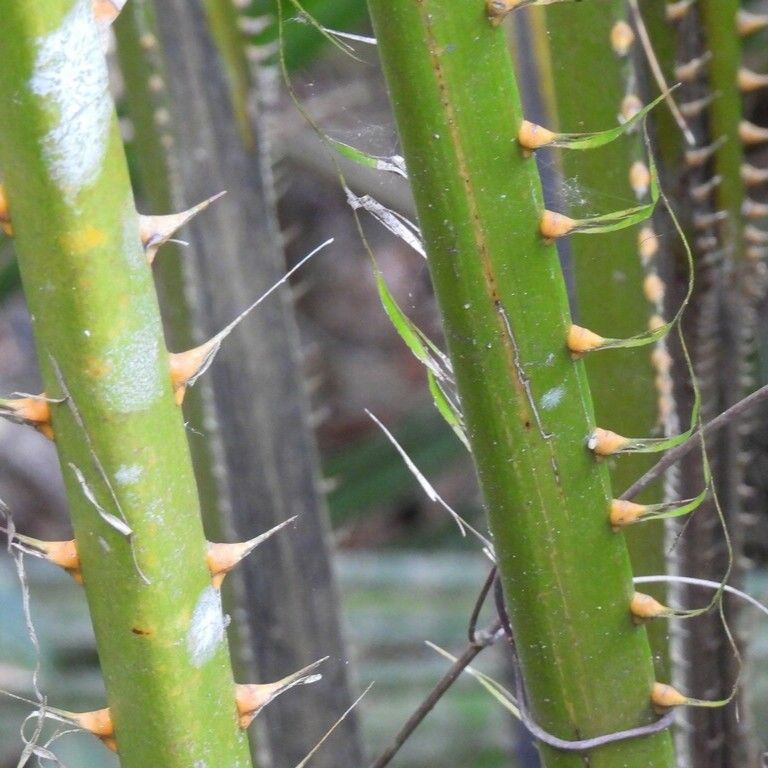
Close-up photo of the petioles of a palm. The spines are present on the edges of the petioles. The remnants of the leaf lamina are still clinging to some spines.
The spines on Elaeis guineensis (African oil palm) petioles are the hardened midveins that remain after the lowermost leaflets senesce. Diabolical! 📷: Diane Bricmont CCBYNC4 #Arecaceae #spine #Botany 🌾🧪🌱
04.12.2025 11:50 — 👍 61 🔁 8 💬 1 📌 0
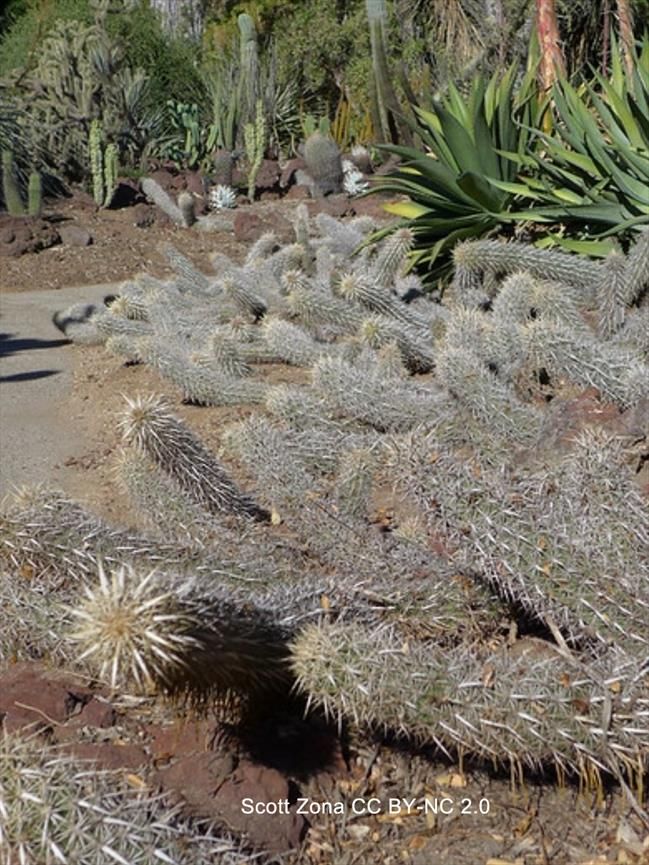
Photo of many decumbent stems (their tips turned upward) of a cylindrical cactus. The stems are bristling with spines of various sizes. Photo by Scott Zona CC BY-NC 2.0.
No plant does spines better than cacti, and none is spinier than Stenocereus eruca, a decumbent species from Baja California, Mexico. They are spines because they are modified leaves. #Cactaceae #spine #Botany 🌾🧪🌱
03.12.2025 16:32 — 👍 41 🔁 5 💬 1 📌 0

Alt: Photo with POV looking down on the shoots of this plant with opposite leaves. Each leaf is three-lobed, and each lobe ends in a spine tip.
Many leaves (or parts of leaves, such as the leaf tip or leaf margin) are modified into sharp defensive armaments. Modified leaves or leaf parts are spines. This Osmanthus heterophyllus 'Sasaba' has wonderfully spiny foliage. 📷: Arb O'Retum CCBYNCSA2. #Oleaceae #spine #Botany 🌾🧪🌱
03.12.2025 11:30 — 👍 169 🔁 15 💬 3 📌 0
🫡 Understood.
02.12.2025 23:33 — 👍 0 🔁 0 💬 0 📌 0

Photo of leafy branches (the leaves beginning to yellow and fall) with recurved prickles scattered on the stems. Photo by Scott Zona CC BY-NC 4.0.
Thorns are modified stems/branches, so these things on roses are NOT thorns. They are officially called prickles, which are epidermal outgrowths. Sorry, Poison, Every Rose Does NOT Have a Thorn. NB: These prickles have another function: they help the shrub climb. #Rosaceae #prickle #Botany 🌾🧪🌱
02.12.2025 16:58 — 👍 50 🔁 12 💬 3 📌 0
😄😄😄
02.12.2025 16:35 — 👍 0 🔁 0 💬 0 📌 0

Photo of a branch bearing leaves and thorns. Many of the thorns have leaves and fleshy red fruits. Photo by Scott Zona CC BY-NC 2.0.
Branches or stems modified into sharp, defensive armaments are properly called thorns. Some thorns even bear leaves & axillary buds, or in the case of this Castela tortuosa, leaves & fruits. #Simaroubaceae #thorn #Botany 🌾🧪🌱
02.12.2025 11:30 — 👍 43 🔁 7 💬 2 📌 0
Yes, but the "walking" part is a big overstatement.
01.12.2025 18:42 — 👍 2 🔁 0 💬 1 📌 0

Photo of the cone of stilt roots on a palm. The stilt roots are covered with whit. Photo by Scott Zona CC BY-NC 2.0.
Stilt roots of the palm Socratea exorrhiza have little pointy rootlets. These rootlets grow out like regular roots, but they stop growing & harden off to become armaments. From what do they defend the palm? What large herbivore would want to eat hard, woody roots? #root #Arecaceae #Botany 🌾🧪🌱
01.12.2025 16:53 — 👍 74 🔁 9 💬 8 📌 0
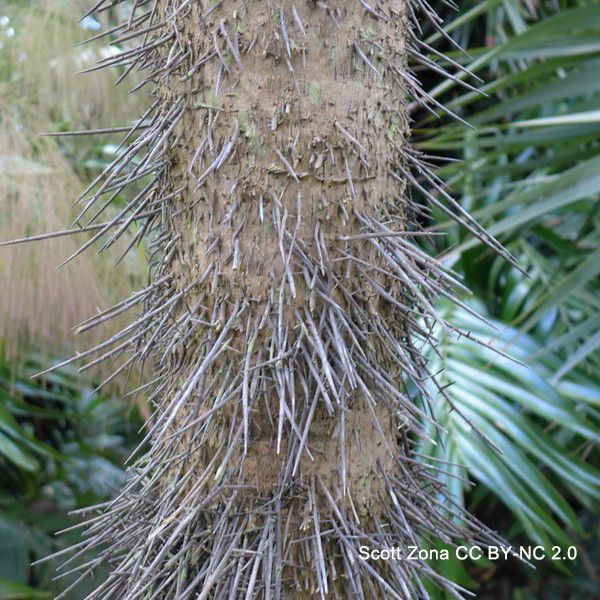
Photo of the trunk of the palm showing numerous, needle-like root spines pointing slightly downward. Photo by Scott Zona CC BY-NC 2.0.
Many plants defend themselves with physical defenses. Spikey armaments, at various scales, are the subject of this week’s posts. Let’s start with root spines: Adventitious roots that harden & become sharp. Cryosophilla palms do it best. 📷: Cryosophila warscewiczii #root #Arecaceae #Botany 🌾🧪🌱
01.12.2025 11:30 — 👍 75 🔁 10 💬 1 📌 0

Photo of a shrub with unusual leaves. They are spatulate, with a strong midvein, but the blade on one side of the midvein is narrower than that of the other side. Photo by Scott Zona CC BY-NC 2.0.

Photo of a very densely branched shrub with arching twigs bearing tiny leaves. Photo by Scott Zona CC BY-NC 2.0.

Photo of an inflorescence bearing two open flowers. The corolla lobes are swept back and reveal the stamens and stigmas. The lobes are pink at their tips, grading through white to yellow at the base. Photo by Scott Zona CC BY-NC 2.0.
I close the week on Primulaceae with a few leftover photos:
1. Myrsine asymmetrica of New Caledonia has asymmetrical leaves. Very weird!
2. Myrsine divaricata is one of New Zealand’s divaricating shrubs.
3. Primula clevelandii var. clevelandii (formerly Dodecatheon c.)
#Primulaceae #Botany 🌾🧪🌱
29.11.2025 11:11 — 👍 84 🔁 10 💬 0 📌 1
Samolus in Florida is also a coastal species.
28.11.2025 19:04 — 👍 2 🔁 0 💬 0 📌 0

Close-up photo of a hairy peduncle bearing bracts, bud, and an open white flower.
Stimpsonia chamaedryoides, 1 of just 2 spp. in the genus, is from China, Korea & Japan. It is sister to the remaining Primuloideae, the clade that includes the herbaceous cultivated primulas (Primula, Dionysia, Androsace, etc.). 📷: Bahamut Chao CCBYNCND2
28.11.2025 11:29 — 👍 171 🔁 15 💬 2 📌 0

Close-up photo of the base of the plant with paddle-shaped leaves with strong, red midveins.
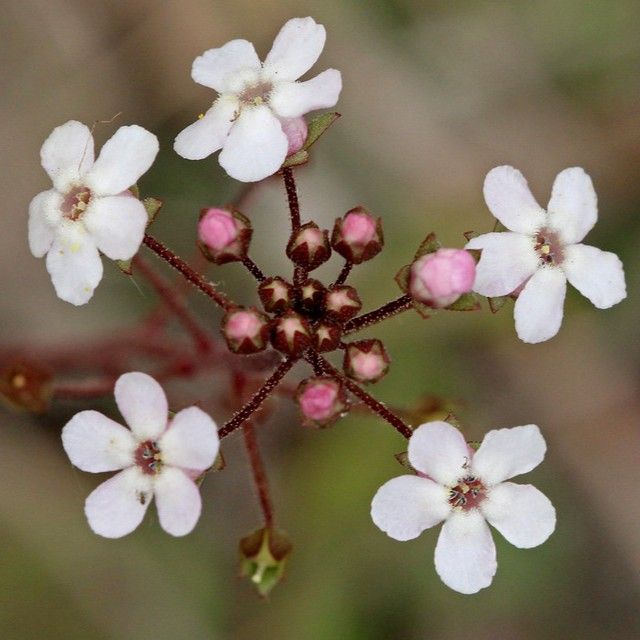
Close-up photo from above of an umbel of white, 5-lobed flowers. The buds are pink and partially enclosed by red sepals.
Samolus (just 14 species) is cosmopolitan. This is Samolus ebracteatus from Florida (also TX, Mexico, the Caribbean). It has an interesting phylogenetic position: It is sister to the Theophrastoideae clade (Clavija & kin; see Tuesday’s post). 📷: Mary Keim CCBYNCSA2. #Primulaceae #Botany 🌾🧪🌱
27.11.2025 11:57 — 👍 137 🔁 6 💬 1 📌 0
The Institute for Regional Conservation reports:
Ardisia elliptica has been found in the following 6 habitats :
Alluvial Forest
Disturbed Upland
Marl Prairie
Pine Rockland
Prairie Hammock
Rockland Hammock
26.11.2025 18:46 — 👍 1 🔁 0 💬 0 📌 0

Photo of low-growing subshrub with dark (almost black), glossy leaves. Each leaf has a silver margin. Photo by Scott Zona CC BY-NC 2.0.
Ardisia also has some really spectacular species, like this one I photographed growing on the forest floor in a Malaysian rainforest. I still don’t have a species name for it, but no matter. I love it. 😍 #Primulaceae #Botany 🌾🧪🌱
26.11.2025 16:51 — 👍 46 🔁 4 💬 5 📌 1
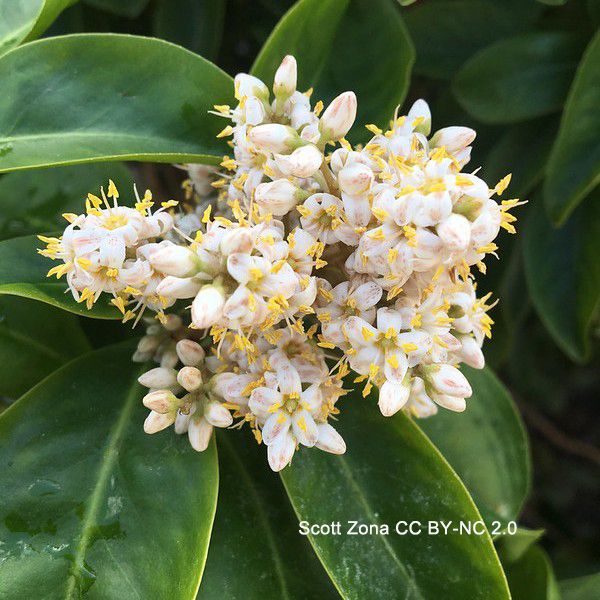
Close-up photo of a cluster of white flowers against dark green leaves. The flowers have petals with dark spots and lines, typical of the Myrsinoideae. Photo by Scott Zona CC BY-NC 2.0.

Close-up photo of a cluster of pink flowers. The anthers are held in a cone, suggesting buzz-pollination. Styles long. Photo by Scott Zona CC BY-NC 2.0.
Ardisia (739 spp) is a pantropical member of the Mysinoideae. The ones I know best are shrubs & small trees. Some are cultivated; some are invasive.
1. A. escallonioides is native to FL.
2. A. elliptica is an Asian species naturalized in FL.
#Primulaceae #Botany 🌾🧪🌱
26.11.2025 11:30 — 👍 114 🔁 9 💬 2 📌 0
You need to see the flowers to see antipetalous stamens and free central placentation. But the DNA evidence is there too.
25.11.2025 18:28 — 👍 1 🔁 0 💬 0 📌 0

Photo of a single, erect shoot bearing a rosette of long, strappy leaves at its apex. Leaf litter is trapped in the crown. Below the crown of leaves are dangling racemes of small, orange flowers. Photo by Scott Zona CC BY-NC 2.0.
Clavija is a Neotropical genus of 56 spp, some of which, like this C. weberbaueri, are litter-trapping Schopfbaum treelets. They have strappy leaves in rosettes that capture litter. For more information on litter-trapping, see our paper: doi.org/10.1111/boj....
#Primulaceae #Botany 🌾🧪🌱
25.11.2025 16:51 — 👍 91 🔁 14 💬 1 📌 0

Photo of detached branch with leaves and fruits against a black background, with a ruler for scale. The fruits are curved and pointed, like little horns.
Tropical Primulaceae are often large, woody plants that occupy diverse habitats. Aegiceras corniculatum is a mangrove tree from SE Asia to Australia. The genus name means “goat horn,” & the epithet means “little horn.” Both refer to the fruits. 📷: Reuben CJ Lim CCBYNCSA2 #Primulaceae #Botany 🌾🧪🌱
25.11.2025 11:30 — 👍 37 🔁 7 💬 1 📌 0
I was trying to spare you…
24.11.2025 23:01 — 👍 1 🔁 0 💬 0 📌 0

A line drawing of two flowers in longitudinal section illustrating heterostyly. The left flower is labeled "Long-styled form," and the right flower is "Short-styled form."
Primula veris is heterostylous with long- and short-styled morphs. Only cross-pollinations result in seed. Darwin was fascinated by this dimorphism within a single species. I give you Figure 1 from The Different Forms of Flowers on Plants of the Same Species. #heterostyly #Primulaceae #Botany 🌾🧪🌱
24.11.2025 16:59 — 👍 29 🔁 5 💬 3 📌 0

Photo of an auricula theater with 4 shelves under a proscenium arch. 27 potted plants with variously colored flowers are on display. Photo by Scott Zona CC BY-NC 2.0.

Close-up on a single auricula with pink and yellow flowers and a ring of white farina. Photo by Scott Zona CC BY-NC 2.0.
Primula includes species commonly cultivated. Gardeners recognize a few broad kinds, including the auriculas, which are traditionally (in the UK, at least) displayed in “theatres,” like this one at Stockton Bury Gardens. Their intricate flowers often have a mealy coating. #Primulaceae #Botany 🌾🧪🌱
24.11.2025 16:42 — 👍 60 🔁 10 💬 1 📌 2
A better way to buy books online where every purchase supports local bookstores ☀️📚
https://bookshop.org/
Climate Change Ecologist, Director of Carbon Science @ Living Carbon.
Presently trying to reduce and remove GHG from the atmosphere. All comments my own.
www.timothymperez.com
PhD Candidate at WSU in Eric Roalson’s lab studying the diversification of Hawaiian Cyrtandra.
Biophysicist, University of Buckingham, UK
luca.turin@buckingham.ac.uk
lucaturin.substack.com
North Carolina's new digital statewide magazine. In-depth reporting and writing about the state. Reach out info@theassemblync.com.
Assistant Professor at @DukeBiology. #NewPI #EvoDevo, gene regulation, adaptive traits, #Wnt signaling 🦋. 🧬🔬🧪. She/her/Ella
Mesomediterranean botanist | #PlantConservation | #InvasiveAlienPlants | #CitizenScience | #Conifers | #UrbanFlora | @jovenesbotanica.bsky.social Co-founder 🌱
https://www.linkedin.com/in/adrian-garciarodriguez/
Postdoc and level 5 Plant Programmer 🧬
Engineering new types of flowers for art and education 🌹
www.nickdesnoyer.com
News Director for @wchlchapelboro.bsky.social in Chapel Hill, NC. Lots of local news posts, occasional sports and film posts.
Maybe this app is The One™?
(He/Him)
Horticulturist, ex-chef, ex-culinary arts instructor, writer.
Author of "Back to the NEW Basics [of gardening]" (https://a.co/d/a1YPIil). Human companion to a Cavalier King Charles Spaniel. Liberal.
Visit my Substack: https://joeseals.substack.com
husband, botanist, Kentuckian, addictive personality, secretly likes Jackass and toilet humor
Botanist. Plant systematics, aquatic plants, invasive species
The lighter side of science 🚀🧪🔭🧬 For more: https://sked.link/iflscience
Your Only Source For Professional Dog Ratings
nonprofit: @15outof10.org ❤️🩹
links.weratedogs.com
I am America’s Best Christian™. But you knew that. You can find exclusive content here: https://www.patreon.com/c/MrsBettyBowers
TITHE: https://www.paypal.com/donate/?hosted_button_id=Q6REDKBBVUJLU
Postdoc - Latvis Lab, University of Arkansas. Interested in plant hybridization, evolution, phylogenetics and genomics. Opinions are my own. he/him 🏳️🌈🇧🇷
Australian native plants| Hakeas| botanical and natural history books| North Queenslander| Living on Gurambilbarra Country | Humanist|
Mostly my photos 📷
🌱Gardening & Botanical insights from Award-Winning Horticulturist, Hybridist, Author, Designer & Consultant Robert F. Gabella.
Naturalist 🦋 birder 🦉 ornithologist & hummingbird researcher 🪶 field guide author 📖 photographer 📷 artist 🎨 gardener 🌱 chicken/dog mom, desert rat, border resident 🇺🇲🇲🇽, democracy fan 🗽. She/her.
https://bio.link/sherilwilliamson
Entomologist and award-winning photographer. Professional breeder and wrangler of insects and arachnids for educational, research and display purposes.






















